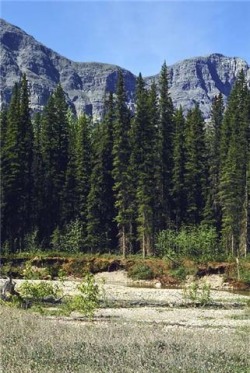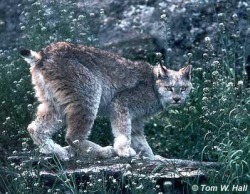Biome: Boreal Forest

Plant Species:
Ex. Coniferous trees, broad leaf plants, black spruce, white spruce, firs, pines, hemlocks and larches
There are variety of plants are in the boreal forest, but the dominant plant would be coniferous trees such as firs, pines, spruces, hemlocks and larches. These trees shed snow easily, and retain their well-adapted, think waxy coated needles through the winter. The needles can resist cold conditions and minimize water loss. Together, these adaptations mean that even in cool conditions, photosynthesis can proceed. Also, its seeds are food resources for some species of birds and mammals. In addition to the conifers, mosses and lichens are also important in the boreal forest and may be part of the diet for many animals.
Broad leaf plants usually lose their leaves in freezing conditions during the fall and will not re-grow until a period of time. The growing season of broad-leafed trees is much shorter than it is for coniferous trees, and the advantage the coniferous trees gain allows them to dominate in the cold climate.
Ex. Coniferous trees, broad leaf plants, black spruce, white spruce, firs, pines, hemlocks and larches
There are variety of plants are in the boreal forest, but the dominant plant would be coniferous trees such as firs, pines, spruces, hemlocks and larches. These trees shed snow easily, and retain their well-adapted, think waxy coated needles through the winter. The needles can resist cold conditions and minimize water loss. Together, these adaptations mean that even in cool conditions, photosynthesis can proceed. Also, its seeds are food resources for some species of birds and mammals. In addition to the conifers, mosses and lichens are also important in the boreal forest and may be part of the diet for many animals.
Broad leaf plants usually lose their leaves in freezing conditions during the fall and will not re-grow until a period of time. The growing season of broad-leafed trees is much shorter than it is for coniferous trees, and the advantage the coniferous trees gain allows them to dominate in the cold climate.

Animal Species:
Ex. Cats (Siberian tiger, lynx, bobcat), dogs, porcupine, snow hare, rodents, grizzly, wolves, spruce grouse, saw-whet owl, woodpeckers, deer, moose, coyote, squirrel, black bear, insect-eating birds and seed eaters
Numerous animal species are found in coniferous forests. Other than the main carnivores of the boreal forest are a number of field of cats and dogs. The cats range in size from the Siberian tiger, down through the lynx to the bobcat. Among the smaller mammalian herbivores are the arboreal (tree-living) porcupine and the terrestrial snowshoe hare.
When the snowshoe hare starts the winter transformation (camouflaging), then the snowshoe hare starts the winter transformation, the brown coat that camouflaged it so well in the summer and fall is beginning to be shed and replaced with white fur that will help hide it in the winter snow.
Mammalian predators in the coniferous forest range from the small, like the bobcat, which feeds on rodents, hares and other small prey, to the Grizzly which is capable of taking down very large prey. Much of the meat that grizzlies eat may be scavenged from the carcasses of large herbivores killed by winter conditions or other predators, such as wolves. Candid are important carnivores in the boreal forest.
Porcupines are is well-protected against their predators (bobcats) as they have sharp spines and they spend much of their time in the trees.
Ex. Cats (Siberian tiger, lynx, bobcat), dogs, porcupine, snow hare, rodents, grizzly, wolves, spruce grouse, saw-whet owl, woodpeckers, deer, moose, coyote, squirrel, black bear, insect-eating birds and seed eaters
Numerous animal species are found in coniferous forests. Other than the main carnivores of the boreal forest are a number of field of cats and dogs. The cats range in size from the Siberian tiger, down through the lynx to the bobcat. Among the smaller mammalian herbivores are the arboreal (tree-living) porcupine and the terrestrial snowshoe hare.
When the snowshoe hare starts the winter transformation (camouflaging), then the snowshoe hare starts the winter transformation, the brown coat that camouflaged it so well in the summer and fall is beginning to be shed and replaced with white fur that will help hide it in the winter snow.
Mammalian predators in the coniferous forest range from the small, like the bobcat, which feeds on rodents, hares and other small prey, to the Grizzly which is capable of taking down very large prey. Much of the meat that grizzlies eat may be scavenged from the carcasses of large herbivores killed by winter conditions or other predators, such as wolves. Candid are important carnivores in the boreal forest.
Porcupines are is well-protected against their predators (bobcats) as they have sharp spines and they spend much of their time in the trees.

